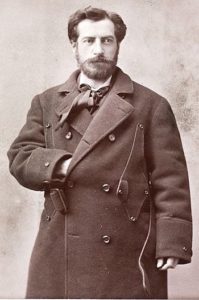
Frederic Bartholdi, 1880
*Frederic Bartholdi was born on this date in 1834. He was a white-French artist and sculptor who designed the Statue of Liberty for France as a gift to the United States of America.
Frederic Auguste Bartholdi was born in Colmar, France, to a family of Italian and German Protestant heritage. Bartholdi was the youngest of their four children and one of only two to survive infancy, along with the oldest brother, Jean-Charles, who became a lawyer and editor. His father, a property owner and counselor to the prefecture, died when Bartholdi was two years old. Afterward, Bartholdi moved with his mother and older brother Jean-Charles to Paris, where other family resided. The family often returned to Colmar for long periods, and they maintained ownership and visited their house in Alsace, which later became the Bartholdi Museum.
While in Colmar, Bartholdi took drawing lessons from Martin Rossbach. In Paris, he studied sculpture with Antoine Etex. He also studied architecture under Henri Labrouste and Eugène-Emmanuel Viollet-le-Duc. Bartholdi received a baccalaureate from the Lycee Louis-le-Grand in Paris in 1852. He then went on to study architecture at the École nationale supérieure des Beaux-Arts and painting under Ary Scheffer. Later, he turned his attention to sculpture, which afterward exclusively occupied him.
The work for which Bartholdi is most famous is Liberty Enlightening the World, better known as the Statue of Liberty. Like many liberal-minded Europeans, he was unnerved by the assassination of U.S. President Abraham Lincoln in 1865, viewing it as a blow to liberty in America. A friend of Bartholdi's, historian Edouard-Rene de Laboulaye, also expressed dismay over Lincoln's death. Over dinner one evening, the two men discussed the possibility of a gift France might deliver to America on the upcoming centennial anniversary of her independence from Britain. Soon after establishing the French Third Republic, the project of building some suitable memorials to show the fraternal feeling between the republics of the United States and France was suggested. In 1874, the Union Franco-Americaine (Franco-American Union) was established by de Laboulaye.
Also, Bartholdi's hometown in Alsace had just passed into German control in the Franco-Prussian War, further influencing Bartholdi's great interest in independence, liberty, and self-determination. Bartholdi subsequently joined this group, including Laboulaye, Paul de Rémusat, William Waddington, Henri Martin, Ferdinand Marie de Lesseps, Jean-Baptiste Donatien de Vimeur, Comte de Rochambeau, Oscar Gilbert Lafayette, François Charles Lorraine, and Louis François Lorraine. His idea of a massive statue design was approved, and the Union Franco-Americaine raised more than 1 million francs throughout France to build the statue. In 1879, Bartholdi was awarded a design patent, U.S. Patent D11,023, for the Statue of Liberty.

On July 4, 1880, the statue was formally delivered to the American minister in Paris and celebrated with a great banquet. In October 1886, the structure was officially presented as the joint gift of the French and American people and installed on Bedloe's Island in New York Harbor. It was rumored in France that the face of the Statue of Liberty was modeled after Bartholdi's mother. The statue is 151 feet and 1 inch high, and the top of the torch is 305 feet, 1 inch from the mean low-water mark. It was the most significant work completed up to that time.
In 1875, he joined the Freemasons Lodge Alsace-Lorraine in Paris. 1876 Bartholdi was one of the French commissioners in 1876 to the Philadelphia Centennial Exposition. There, he exhibited bronze statues of The Young Vine-Grower, Génie Funèbre, Peace, and Genius in the Grasp of Misery, receiving a bronze medal for the latter. That same year, he married Jeanne-Emile Baheux in Providence, Rhode Island. His 1878 statue, Gribeauval, became the property of the French nation, and he received the rank of Commander of the Legion of Honor in 1886. A productive creator of statues, monuments, and portraits, Bartholdi exhibited at the Paris Salons until he died in 1904. He also remained active with diverse mediums, including oil painting, watercolor, photography, and drawing.
Frederic Bartholdi, 70, died of tuberculosis in Paris on October 14, 904. Throughout his life, Bartholdi maintained his childhood family home in Colmar, France, which, in 1922, was made into the Bartholdi Museum after his death in 1904.
To be an Artist